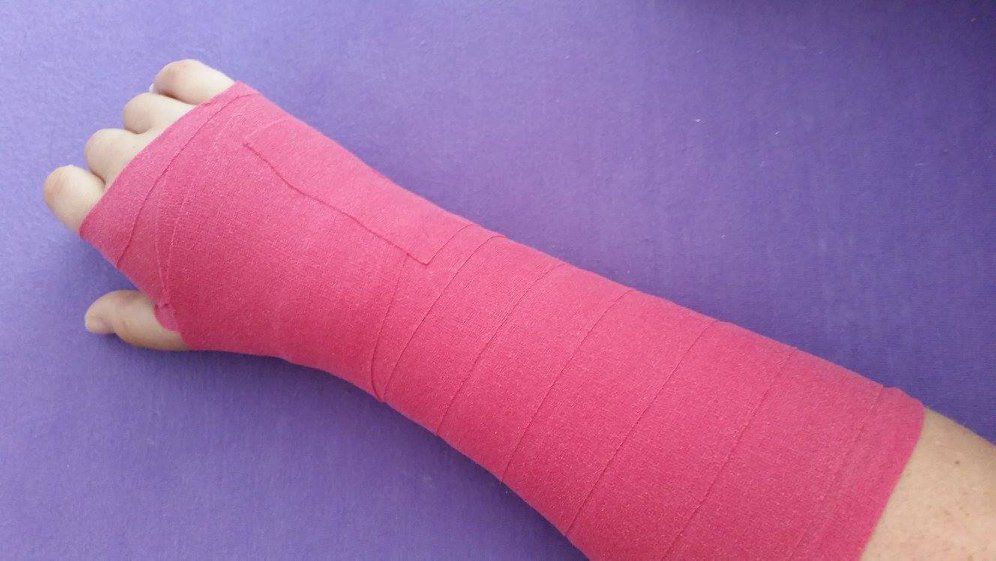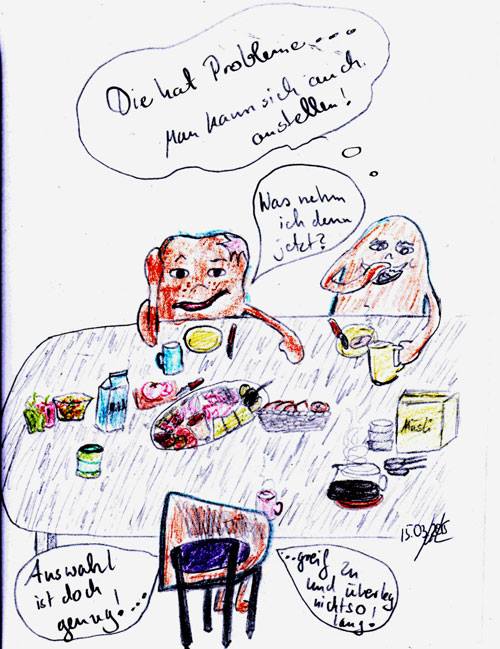therapy
(Meanwhile the guideline of the DGH adopted under the coordination of Prof. Dr. med. Margot C. Wüstner from Ulm. Date of creation June 1999 and last revision before adoption June 2001 Simplified "translation" by me into lay German - as you can see from the "technical jargon". Would you have understood that too? - good doctors explain the issues to patients well :-))
The guideline here should be read carefully, as overlaps are mentioned in each case. Otherwise it is possible that one regards a surgical method as not possible, although it would actually belong to it.
Treatment principle
Pressure relief of the lunate bone to improve blood flow and stability.
Conservative = without surgery or preventive = to prevent an operation
Immobilization in a circular forearm cast for at least 6 weeks only makes sense in stages I and II. (Circular forearm plaster cast means breathable and therefore better for the skin -> if you have already been wearing a plaster cast for 4 weeks, you will know why ...)
If the launate malacia is still in its infancy, the moonbone can be protected from further destruction with the help of a plaster splint or a support bandage that can be obtained in a medical supply store on the doctor's prescription. Unfortunately, this method usually doesn't work.
Forms of electrotherapy such as the tens device can be used. The pain is often more bearable while the power is on.
The following should also be mentioned:
- Physiotherapy, osteopathy, sometimes also occupational therapy ... (keywords: acupressure, holistic treatment)
- acupuncture - food supplements - autologous blood treatment (so far no evidence of effects on LM) - healing earth - heat treatments
- leech treatment ... (may be added)
Diet changes depending on the blood value constellation.
So far, these have only achieved success with differentials. However, it is not easy to first ask yourself completely what you are actually eating.
If you intend to change your diet, you should start with a food diary. Here it is noted what and in what quantities you actually eat throughout the day. Then you take a closer look at content such as cholesterol, carbohydrates, sugar and other components and slowly start to change little things. E.g. less sugar and fats. Only then keep changing over and creeping into the day so that the changeover succeeds.
operating
If the previous method is no longer possible (because of the stage) or the first method did not help, the following methods come into play:
- Stage I to IIIa with ulnar plus variant: Decompression through trepanation (Comment from the webmaster: Health! - I can't translate yet, but I'm working on it ... Of course we know what is being done and what is behind it At this point, there is a lot of research and processing in our pages. If you look around the net, you will quickly find that mostly technical jargon is used ... So continue with the simplified explanation by the webmaster :) Here is the translation : Pressure relief through removal - mostly - 3 pieces from the lunate. Comparable to the head of a pin. This method also includes the predi-drilling, which comes from the knee treatment. Here, "only holes" are drilled into the lunate, instead of being removed, and sent in for more detailed differential diagnosis. At the same time as the differential diagnosis, both decompression and predi-drilling can be successful in therapy: the right spots of the circulatory disorder are hit (like a 6 in the lottery) and the moonbone regenerates, begins to revive and heals. In contrast to knee treatment, this is called a Beck's hole in one hand. Trepanation and Beck's drilling differ as follows: Trepanation is sent in and the bone material B. Intraosseous ganglion examined. Beck's borehole, on the other hand, is a pure borehole without laboratory testing.
- Cancellous bone filling - bone marrow is removed (iliac crest, for some years also knee) and transplanted into the decomposed lunar bone. Another type of operation to treat lunate malacia is autologous bone marrow transplantation. During this procedure, bone marrow is removed from the hip (usually on the side of the wrist with the lunate malacia) and this bone marrow is reinserted into the lunar bone. With this one tries to achieve that the carpal bone regenerates and rebuilds itself.
- Revascularization operation (vascular-pedicled transplantation of the os pisiforme) = the OS pisiform is the smallest carpal bone in the wrist and this is implanted (= implanted) into the lunar bone as part of the radius metaphysis to improve blood circulation, similar to spongiosaplasty Bone block implanted instead of or as a supplement to the crumbled, broken moonbone or cancellous bone transplant with vascular implantation = I don't know yet ... you maybe? Webmaster knows: "Bone chips" containing blood vessels to revitalize the lunate intercarpal partial arthrodesis = partial stiffening. s. listed again below.
- Stage I to IIIa with ulnaminus and ulnanull variants (This corresponds to a misalignment of the ulna / radius in relation to the position of both forearm bones recognized as normal in the body. This misalignment often has the effect that the lunar bone in question has to withstand more pressure than usual and not withstand this pressure):
Level operations (radius shortening = ulna is shortened or ulnar lengthening = spoke is lengthened), with ulnar nerve variant from wedge osteotomy of the distal radius (this corresponds to a small bone chip that is removed from the radius) with one type of operation - this depends entirely on the respective stage of the lunate malacia from - the spoke is shortened in such a way that the proportions of ulna and spoke are equal again and thus balanced. Here, the spoke is sawn into pieces, a piece removed from it and the front piece of the bone fastened again with the help of a metal plate or a long thin metal rod and possibly screws. This surgical method is often done when the patient's ulna is shorter than the radius (a so-called minus variant of the ulna).
- Stage IIIb: Pressure relief of the lunar bone and correction of the misalignment of the scaphoid bone through partial intercarpal arthrodesis (= the lunar bone is relieved. This means the incipient so-called carpal collapse - shifting of the carpal bones, usually the scaphoid bone slipping downwards. Here carpal bones are usually stopped with the help of bone marrow and wires merged into a bone.)
- Alternatively in stages II to IIIb: excision of the proximal carpal row (Proximal Row Carpectomy) Here the lower row of the carpal bones is removed and a simplified hinge is created through the longer scaphoid bone. (see also healing) Stage IV: radiocarpals or complete wrist arthrodesis. STT arthrodesis only if the osteoarthritis is still limited to the radiolunar joint section and the hyperflexion position of the scaphoid bone can be largely corrected. All right, right? - So: Arthrodesis means stiffening of the wrist. In most cases, all carpal bones are joined together with the help of bone marrow and wires. Which bones are to be joined together when and how exactly this works can only be decided by the doctor on the basis of the corresponding effects of the carpal collapse. If the wrist is fully stiffened, the wrist remains in the basic position, which means that it looks as if the hand is constantly gripping something and only the fingers remain mobile.) Note on STT arthrodesis: The word intercarpal partial arthrosis, partial arthrodesis or partial fusion is / are more appropriate here. STT usually stands for Scaphoideum / Trapezium / Trapezoideum, but is also used as a term for other partial arthrodesis s. also pictures of partial arthrodesis, because these are also part of it, before full stiffening is an option .... In all stages of lunate necrosis, partial or complete denervation (= cutting of pain-spreading nerve tracts in the wrist) can be carried out, both alone and as additional intervention.
- Lengthening of the headbone after lunar excision - which stages? Decision at the doctor, unfortunately I don't know.
- Not assigned and meanwhile also out of date for lunate malacia: tendon interposition The removal of the lunar bone and replacement with a tendon ball. During this procedure, the diseased lunar bone is first removed. In the hand area there is a tendon that is not needed to move the fingers and hand - a "blind" tendon, so to speak. This tendon is - so one suspects - a remnant of our ancestors who apparently had a different movement of the hand in some form or something. In any case, this tendon is removed from the said hand, formed into a ball and, last but not least, placed in the place of the lunar bone. General anesthesia is not absolutely necessary for this operation and from my own experience I can say: "It is really very interesting what doctors, nurses and the rest of the OR staff talk about during an operation."
outpatient / inpatient
The sole leveling operation with or without denervation can be carried out on an outpatient basis in individual cases. All other interventions are to be carried out under inpatient conditions.
Aftercare
Immobilization in a forearm cast from 10 days to 8 weeks, depending on the surgical method. Active movement exercises without strain after lifting the immobilization. If the lunate is preserved, avoid excessive stress (impact, shock, shaking, vibration) for 3 to 6 months.
Therapy control through clinical and X-ray examination. If the moon bone is preserved: additional MRI.











